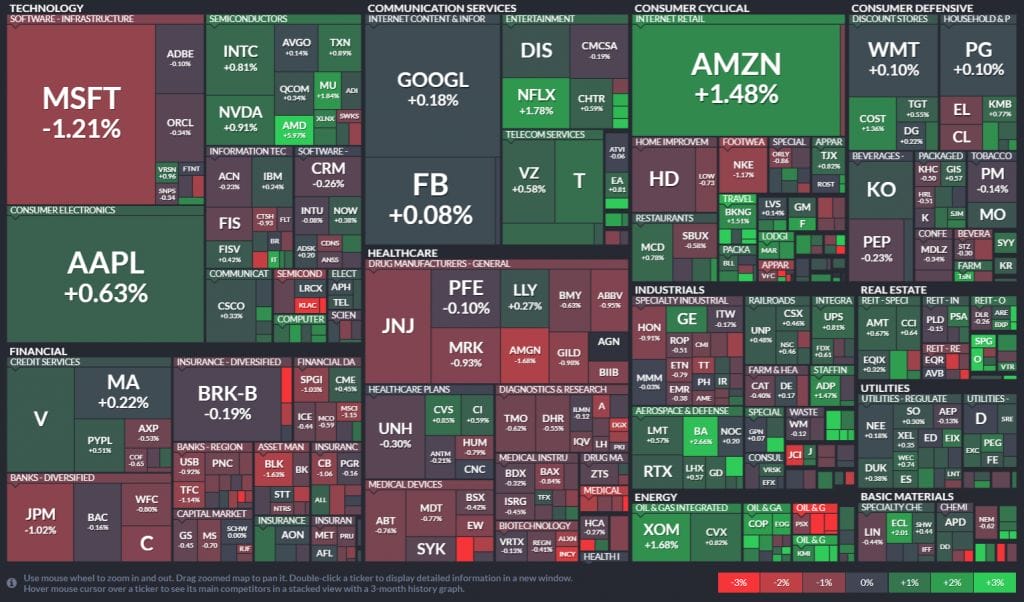Creating an industry map shouldn’t be an arduous task with some basic research, especially with all of the tools available on the internet today. Here’s an example industry map using the S&P 500, with a break-out into 11 major sector components, followed by more detail industry markets.
To create the major sector components map, I’m simply going to start with the sectors defined by finviz, which creates a good overall picture of what currently moves the market.
You can’t ignore these big players, as their large market size and market share often go hand-in-hand.

Here are 11 major sectors of the S&P 500 that nicely describe a general market industry map:
- Technology
- Healthcare
- Financial
- Communication Services
- Consumer Cyclical
- Consumer Defensive
- Industrials
- Energy
- Real Estate
- Utilities
- Basic Materials
I tried to make the list in descending order of market size (as defined by current market capitalization), which has its own faults, but we’ll try to be vaguely correct here instead of precisely wrong.
Here’s a nice illustration of the industry map I defined with the 11 major sectors above, again from the same source in their mapping function:
You’ll notice there’s some overlap here.
As an example, Apple ($AAPL) could be classified in consumer cyclical or consumer defensive instead of tech (people always seem to want to upgrade their phones). Disney is a similar story, as their entertainment businesses like Disney+ streaming and broadcasting (ABC, ESPN) falls naturally into Communication Services, while their theme parks and consumer goods licensing could also be considered consumer cyclical.
This type of detail is more important as you get deeper into a specific industry analysis, while a broader industry map can be more fuzzy and harder to define.
Along those same lines, there’s no perfect industry map of the business world. Even among the NAICS categories reported in government reports like the monthly retail sales by the U.S. Census Bureau, there can be misclassifications and missing competitors.
For the sake of business analyses, detailed industry maps on complicated business conglomerates should probably be segmented, similar to a sum of the parts valuation model.
Industry Map: 50 Businesses from the S&P
This section will take the general stock market sectors and include major components, which should represent much of the market’s move on any given day.
However, even more critical than that, I believe that tracking the business characteristics of market leaders not only informs competitors of what’s working now, but also illustrates changes in the business models and strategies of the leading stocks—which receive a disproportionate amount of the attention and spotlight in business.
Note: One potential fault of doing this is that it ignores businesses that are currently out of favor yet still have a significant impact in the macroeconomic and general business world, such as major Oil & Gas stocks in the Energy sector.
Again I’ll aim to be generally inclusive for the purposes of this post, and encourage deeper industry analyses particularly within or in addition to the following subsets.
- Technology
- Microsoft / Apple
- Intel / Nvidia
- Oracle / Adobe
- Communication
- Google / Facebook
- Disney / Netflix / Comcast
- Verizon / AT&T
- Healthcare
- Johnson & Johnson
- Pfizer / Merck
- UnitedHealth Group
- Financial
- Visa / Mastercard / Paypal
- Berkshire Hathaway
- JPMorgan / Bank of America / Wells Fargo / Citigroup
- Consumer Cyclical
- Amazon
- Home Depot
- McDonald’s / Starbucks
- Nike
- Consumer Defensive
- Walmart / Costco
- Procter & Gamble
- Coca Cola / Pepsi
- Industrials
- Honeywell / 3M
- Union Pacific
- Lockheed Martin / Raytheon
- Energy
- Exxon Mobil / Chevron
- Real Estate
- American Tower / Crown Castle Intl / Equinix
- Utilities
- Next Era Energy/ Duke Energy / Southern Company
- Basic Materials
- Ecolab
- Sherwin-Williams
That’s a total of 50 businesses, making up 10% of the companies in the S&P 500. These are all U.S. based businesses, so big international S&P components like Accenture, Medtronic, and Linde got left off this list.
You’ll notice I’ve included industry pairings and groups in places where it was obvious to me that the companies directly competed with each other with at least significant portions of their revenue.
Amazon is the outcast in the sense that it competes heavily in cloud with Microsoft and retail with the WMT/CSCO duo, so I just left them as a default finviz classification of Consumer Cyclical on an island all on its own. I’ll admit my circle of competence might not have made accurate assumptions on all of the pairings, so you’ll have to bear with those.
Creating Your Own Industry Map
Consider that an industry map like this will change over time depending on the stock market and economic cycle.
This is due to the large weightings as determined by investor and investor expectations, which can and do fall out-of-line with real business results. Industries and businesses go in-and-out of favor in the investment community all of the time, and so this map is limited to that degree.
Another great industry map idea could be based strictly on revenues rather than market capitalizations, and based on a list like the Fortune 500 rather than the S&P 500.
Additionally, one could average out revenues over a long time period, such as 5-10 years or more, in order to smooth out the long term economic and business cycles that naturally affect businesses of all types in one way or the other.
Final Tip (The Most Important)
When looking at an industry map such as these involving large public corporations, the absolute best place to source relevant financial data would be company annual reports, specifically the 10-k’s required by the SEC.
Not only will you get revenue information that is publicly audited rather than estimated or projected, but it oftentimes is split by segments.
Management of these businesses will often provide valuable commentary and observations that you just can’t find anywhere else, and these can oftentimes be hidden in plain sight, you just have to read closely.
We understand that the 10-k is a daunting read, with most reaching over 100+ pages. That’s why we’ve dedicated places of this website to help, such as this post about dissecting the 10-k in a simplified way.

Andrew Sather
Andrew has always believed that average investors have so much potential to build wealth, through the power of patience, a long-term mindset, and compound interest.
Related posts:
- The Meaning of a Cyclical Industry Explained for Beginners The economy moves in cycles. Good times and bad. Because of this, the stock market also tends to move in cycles. A cyclical industry is...
- What to Know Before Investing in Solar Energy Updated 11/24/2023 Solar power, wind, and hydro are the leaders among energy investments globally, with over $175.8 billion in solar. But what do we know...
- Understanding the Electric Power Grid to Make Better Investments Updated 11/24/2023 The electric power grid is like the air we breathe; we don’t think about it much until something goes wrong. The power appears...
- Business Moat: Essential for the Consumer Goods Industry in a Price War With the emergence of Amazon as the dominant eCommerce retailer, the companies in the consumer goods industry have never needed a business moat more than...

